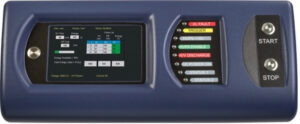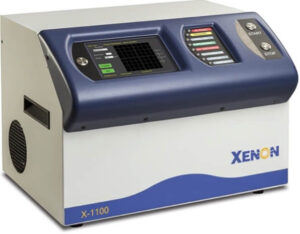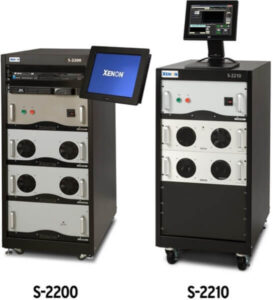There’s a lot of excitement these days in the mushroom industry regarding the power of Pulsed Light and the many ways it can be used to improve health, safety, and nutrition.
In case you missed it, we recently featured a blog about how Pulsed Light is disrupting the mushroom industry with applications like equipment sterilization, Vitamin D enhancement, air safety, and more. In fact, there are so many ways to use Pulsed Light, we thought it would be helpful to answer the most common questions that mushroom growers and processors have about this exciting technology. How does it work? How and where can you install it in your processes? Is it proven and safe?
To get the answers, we went to the experts at XENON—the sales people, scientists, and engineers who work with companies in the mushroom industry on a regular basis. Here are their answers to some of the most frequently asked questions about Pulsed Light and mushrooms.
Q: Have the benefits of Pulsed Light been proven?
A: Absolutely. There are many research reports on the value of Pulsed Light in each of its applications. Its ability to destroy or deactivate harmful pathogens has been known for years, and the FDA has approved its use in food processing. This makes it effective for cleaning conveyors and other food handling equipment, as well as packaging and even the air itself.
The ability of Pulsed Light to enhance the Vitamin D content in mushrooms is also well proven. Multiple studies have found that the sun-like energy of Pulsed Light activates natural processes in mushrooms, spurring them to generate extra Vitamin D—up to ten times the normal amount. Here’s an article on the subject from the Fresh Produce Journal.
Q: What factors go into a successful Pulsed Light solution?
A: In any given application, the effectiveness depends on several factors, including the type of mushrooms being treated, the area to be covered by the Pulsed Light, distance from the target, number of pulses, speed of the conveyor, and many other factors. XENON’s engineers can work with you to achieve the optimum setup for your application.
Q: How fast does Pulsed Light work?
A: Pulsed Light works extremely fast because it delivers high-energy light pulses. This is distinct from low energy UV light, which takes a long time to work because it operates at low temperatures. “Fast” is a relative term, of course, and can mean anything from a few seconds to a few minutes. Every application is different and the timing depends on many factors. In general, however, Pulsed Light can operate at production speeds, and this makes it a very practical solution for food processing applications.
Q: How many light pulses are needed?
A: Again, it varies. To take a real-world example, it only requires between 1 and 3 pulses (at a rate of 3 pulses per second) from a XENON Corporation 16” linear lamp driven by an RC-847 controller to bring the amount of vitamin D in a Portobello mushroom up to more than 100% the Recommended Daily Allowance (compared to 5% and 8% without treatment). The conversion is even greater when the mushrooms are sliced, because this increases the exposed surface. Under those circumstances, the enhancement could be over 500% of RDA.
Q: Can Pulsed Light fit into an existing production line?
A: In general, Pulsed Light can be added to any food processing operation, either by using one of our off-the-shelf systems or by designing a special configuration for your application. For example, our standalone device, the XENON CIXL system, can often be retrofitted to an existing conveyor line. In other cases, XENON or our distributors will work with you to design the optimum installation. Because XENON makes a variety of lamp sizes and shapes, as well as all the other needed components, fitting a system to an existing facility is usually not a problem.
Q: What safety measures are needed?
A: Exposure to high-energy UV light can be harmful, so it’s important to use proper safety measures with Pulsed Light. Common safety measures include protective shielding around the lamp housing, UV-blocking safety glasses for workers, and proper training for everyone who will use the equipment. XENON has years of experience and will help ensure that your installation is safe for its intended use.
Q: Which XENON products are the best fit for mushroom enhancement?
A: As always, it depends on the circumstances. The XENON RC-800 and RC-900 series are a good match for full-scale production settings. For smaller setups, there is the standalone CIXL device mentioned earlier. The Z-series sterilization lamps are developed for surface microbial decontamination, making another great option for conveyor installations. In short, there is a XENON solution for every Pulsed Light application.
More questions?
We’ve tried to answer the most common questions here, but if you didn’t see the answer you’re looking for or you have other questions, please let us know. XENON’s experts are here to help you take advantage of the power of Pulsed Light.
If you’d like to know more about Pulsed Light in the mushroom industry and how you can benefit, please contact us today.
Pulsed Light has been around for a long time, but these days research efforts are growing faster than ever. R&D labs in companies, universities, and government are exploring a myriad of applications such as decontaminating and fortifying food products, sanitizing the air in buildings, curing materials, and more. Across the world and across industries, researchers are finding new applications for Pulsed Light every day.
Many factors are driving this research boom, including the fact that Pulsed Light applications are often directly related to public health and safety. But there’s also an important technology enabler that’s helping to drive this research as well, and that’s the XENON X-1100. First introduced in 2016, this benchtop device has accelerating Pulsed Light research in laboratories around the world by providing a combination of state-of-the-art technology, intuitive controls, and a price that is affordable for most facilities.
What’s behind this remarkable system, and why is it having such an impact?
Designed for R&D scientists and engineers
XENON is the original Pulsed Light company, with thousands of customers and many decades of experience. All of this knowledge went into making the X-1100 the ideal R&D tool.
Dr. Saad Ahmed, XENON’s VP of Operations, explains that the system was developed specifically to meet the needs of researchers: “There just wasn’t a simple enough R&D solution on the market, so we set about to address that. We knew the unit had to be small and compact to fit into a typical crowded lab. It also needed to be plug and play, deployable with a range of equipment. Finally, it needed to be intuitive to learn and use.”
This last goal was especially important. Dr. Ahmed wanted to make the new system as easy to use as a phone app. As he explains it, “You don’t need a manual to know how to use an app. You just go to the download store and tap the icon. We wanted to bring that ease of use to Pulsed Light.”

Easy-to-use interface simplifies Pulsed Light research.
Embraced by researchers
With those ideas in mind, the team at XENON developed the X-1100, the lowest-cost programmable Pulsed Light product on the market. It’s compact and plugs into a standard outlet, with simple controls for pulse duration and voltage, and a touchscreen with a pre-installed app to get users started. The X-1100 is equipped with a fully functioning PC, so it really is as easy to use as your average mobile app.

A complete Pulsed Light system in a benchtop package.
The X-1100 has been embraced by the R&D community and hundreds of units are now in use around the world. According to Dr. Ahmed: “A lot of the complexity behind the machine is hidden from the user. All they need to do is input how much energy and what kind of pulse they want. Then the system figures out the calculations needed to accomplish it. The system makes it very easy for R&D people who don’t want to deal with the complex math behind Pulsed Light. They just want to get on with the test.”
XENON has added several features since the X-1100’s introduction. “It’s mostly mature technology,”, says Dr. Ahmed, “but we’re still finding ways to improve it. Some have requested things like an interface for an external device to tell the X-1100 to flash, or wireless control of basic operations. These features are now built in.”
What if you need more power?
The X-1100 provides a fair amount of power (up to 9 Joules/cm2), but some researchers need more power or need to treat larger areas. The S-2200 and S-2210 fill those needs. These systems are not as simple to use as the X-1100, but they offer many more options for configuring and delivering Pulsed Light energy. Unlike the X-1100, which powers from a wall outlet, the S-2000 series devices use a 3-phase power line on a rack-based system. Though these systems generate greater power and more control, they also require a deeper understanding of photonics by the user.

Getting started
Using Pulsed Light, researchers are finding new ways to make a difference, whether it’s helping protect people from airborne disease, chemical-resistant bacteria, and foodborne illnesses, or developing the next breakthrough in printed electronics or solar cell manufacture.
The XENON X-1100 makes it easy to get started, and the company’s scientists and engineers are ready to help with support and technical knowledge. To learn more, contact XENON today.
